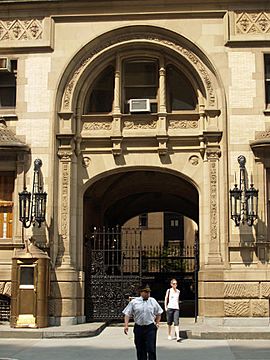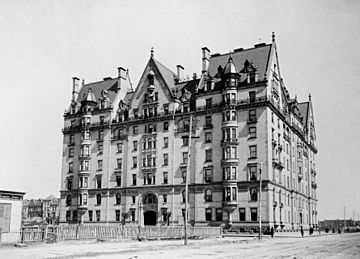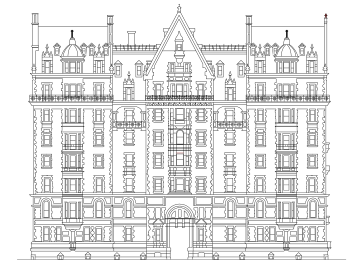The Dakota facts for kids
|
The Dakota
|
|
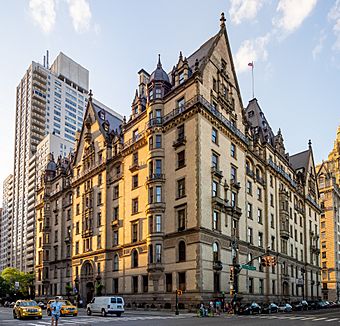
As seen from Central Park West
|
|
| Location | 1 West 72nd Street Manhattan, New York |
|---|---|
| Built | 1881 |
| Architect | Henry Janeway Hardenbergh |
| Architectural style | Renaissance Revival, English Victorian |
| NRHP reference No. | 72000869 |
Quick facts for kids Significant dates |
|
| Added to NRHP | April 26, 1972 |
| Designated NHL | December 8, 1976 |
The Dakota, also known as the Dakota Apartments, is a cooperative apartment building on the northwest corner of 72nd Street and Central Park West in the Upper West Side of Manhattan in New York City, United States. The Dakota was constructed between 1880 and 1884, and was designed by Henry Janeway Hardenbergh.
The Dakota has historically been home to many artists, actors, and musicians, including John Lennon, who was murdered in the archway of the building in 1980. The New York City Landmarks Preservation Commission designated the building as a city landmark in 1969, and it was added to the National Register of Historic Places in 1972.
History
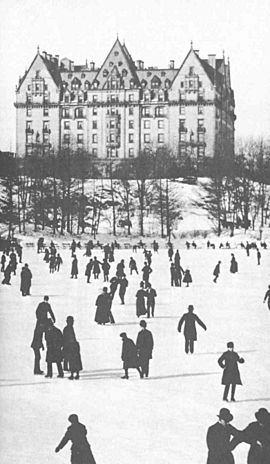
The Dakota from Central Park, c. 1890
|
The Dakota was constructed between October 25, 1880, and October 27, 1884. Henry Janeway Hardenbergh's architectural firm was commissioned to create the design for Edward Cabot Clark, head of the Singer Manufacturing Company. The building purportedly was named The Dakota because at the time of its construction, the area was sparsely inhabited and considered remote from the inhabited area of Manhattan, just as the Dakota Territory was considered remote. The earliest appearance of this story, however, was in a 1933 newspaper interview with The Dakota's long-time manager. Christopher Gray's book New York Streetscapes quotes the interaction thus: "Probably it was called 'Dakota' because it was so far west and so far north". Gray believed that the building's name stemmed from Clark's fondness for the names of the new western states and territories.
The Dakota was designated a New York City Landmark in 1969. It was added to the National Register of Historic Places in 1972, and was designated as a National Historic Landmark in 1976.
British musician John Lennon, a building resident, was shot dead by Mark David Chapman outside the building on December 8, 1980. The building's facade was renovated in 2015.
Design
Exterior
The building's high gables and deep roofs with a profusion of dormers, terracotta spandrels and panels, niches, balconies, and balustrades give it a German Renaissance character and an echo of a Hanseatic town hall. Its layout and floor plan, however, were strongly influenced by French architectural trends in housing design that had become known in New York City in the 1870s. High above the 72nd Street entrance sits the face of a Dakota Indian.
The Dakota is a square building built around a central courtyard. The arched main entrance is a porte-cochère large enough for the horse-drawn carriages that once entered and allowed passengers to disembark sheltered from the weather. Many of these carriages were housed in a multi-story stable building built in two sections between 1891 and 1894, at the southwest corner of 77th Street and Amsterdam Avenue, where elevators lifted them to the upper floors. The "Dakota Stables" building was in operation as a garage until February 2007, when it was slated to be transformed by the Related Companies into a condominium residence. Since then, the large condominium building The Harrison occupies its spot.
An entrance to the 72nd Street station of the New York City Subway's B and C train is outside the building.
Interior
The general layout of the apartments is in the French style of the period, with all major rooms connected to each other, in enfilade, and also accessible from a hall or corridor. The arrangement allows a natural migration for guests from one room to another, especially on festive occasions, yet gives service staff discreet separate circulation patterns that offer service access to the main rooms. The principal rooms, such as parlors or the master bedroom, face the street, while the dining room, kitchen, and other auxiliary rooms are oriented toward the courtyard. Apartments thus are aired from two sides, which was a relative novelty in Manhattan at the time. Some of the drawing rooms are 49 feet (15 m) long, and many of the ceilings are 14 feet (4.3 m) high. The floors are inlaid with mahogany, oak, and cherry.
Originally, The Dakota had 65 apartments with four to 20 rooms, no two apartments being alike. These apartments are accessed by staircases and elevators placed in the four corners of the courtyard. Separate service stairs and elevators serving the kitchens are located mid-block. Built to cater to the well-to-do, The Dakota featured many amenities and a modern infrastructure that was exceptional for the time. The building has a large dining hall. Meals also could be sent up to the apartments by dumbwaiters. Electricity was generated by an in-house power plant, and the building has central heating. Beside servant quarters, there was a playroom and a gymnasium under the roof. In later years, these spaces on the tenth floor were converted into apartments. The Dakota property also contained a garden, private croquet lawns, and a tennis court behind the building between 72nd and 73rd Streets.
All apartments were let before the building opened, but it was a long-term drain on the fortune of Clark, who died before it was completed, and his heirs. For the high society of Manhattan, it became fashionable to live in the building, or at least to rent an apartment there as a secondary city residence, and The Dakota's success prompted the construction of many other luxury apartment buildings in Manhattan.
Cultural significance
The south entrance of the building was the location of the murder of John Lennon and is prominently featured in Andrew Piddington's 2006 film The Killing of John Lennon, although the Dakota itself was only used for exterior shots. In Roman Polanski's 1968 film Rosemary's Baby, the Dakota was used for exterior shots of "The Bramford", the apartment building in which the story takes place. In Jack Finney's 1970 novel Time and Again, the Dakota enables time travel.
- Cardinal.: "The Dakota Apartments: Vintage Articles of the World's Most Famous Apartment Building", Campfire Publishing, 2013
- Cardinal.: "The Dakota Scrapbook, Campfire Publishing, 2014
- Cardinal.: "The Dakota Apartments: A Pictorial History of New York's Legendary Landmark, Campfire Publishing, 2015
- Cardinal.: "A Grand Tour of the Dakota Apartments: A Journey Through Time of the Interior & Exterior of New York's Legendary Landmark, Campfire Publishing, 2015
- Schoenauer, N.: 6,000 Years of Housing, 3rd ed., pp. 335–336, W.W. Norton & Co., 2001. ISBN: 0-393-73120-0.
- Van Pelt, D. Leslie's History of the Greater New York, Volume III New York: Arkell Publishing Company 110 Fifth Avenue, 1898
- L. A. Williams Publishing and Engraving Company. Encyclopedia of Biography and Genealogy, vol. III p. 656.
- Jarrett Schaefer "Chapter 27" Paramount Films, 2007
- Birmingham, Stephen: "Life at the Dakota: New York's Most Unusual Address," Random House, 1979
See also
 In Spanish: The Dakota para niños
In Spanish: The Dakota para niños


